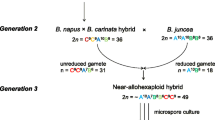Summary
A total of 61 microspore-derived plants of Petunia parodii were grown to maturity revealing a predominent population of triploids, 80.3%. Cytological investigations, together with the evidence from microfluorimetry, suggest that the origin of these triploids was due to the fusion of interphase nuclei in two different pathways. In the majority of embryogenic microspores, a vegetative nucleus of 1C DNA content fused with an endo-reduplicated 2C DNA generative nucleus at the binucleate stage and produced true triploid embryoids and plantlets (A pathway). Where this fusion failed, both the vegetative and the generative nuclei divided separately and in the multinucleate microspore two or more daughter nuclei fused to form a mixoploid embryoid. Such mixoploid embryoids produced a mixed population of plants with various ploidy levels as well as ploidy polymorphism within an individual. Since the triploids are morphologically superior with a faster growth rate than their diploids and related tetraploids, a predominent population of triploid plants was obtained from such mixoploid embryoids (B pathway). By low temperature treatment of the anther-donor buds, the embryogenic response of microspores was enhanced up to 5-fold.
Similar content being viewed by others
Literature
Engvild, K.C. (1973): Triploid petunias from anther cultures. Hereditas 74, 144–147
George, L.; Rao, P.S. (1979): Experimental induction of triploid plants of Physalis through anther culture. Protoplasma 100, 13–19
Hesemann, C.U. (1971): Untersuchungen zur Pollenentwicklung und Pollenschlauchbildung bei höheren Pflanzen. Theor. Appl. Genet. 41, 338–351
Jackson, J.F.; Linskens, H.F. (1978): Evidence for DNA repair after ultraviolet irradiation of Petunia hybrida pollen. Molec. Gen. Genet. 161, 117–120
McComb, J.A. (1978): Variation in ploidy levels of plants derived from anther culture. In: Proceedings of Symposium on Plant Tissue Culture, pp. 167–180. Peking: Science Press
Murashige, T.; Skoog, F. (1962): A revised medium for rapid growth and bioassays with tobacco tissue cultures. Physiol. Plant. 15, 473–497
Nitsch, J.P.; Nitsch, C. (1969): Haploid plants from pollen grains. Science 163, 85–87
Nitsch, C.; Norreel, B. (1973): Effet d'um choc thermique sur le pouvoir embryogéne du pollen de Datura innoxia cultivé dans l'anthère ou isolé de l'anthere. C.R. Acad. Sci. (Paris) 276, 303–306
Raquin, C.; Pilet, V. (1972): Production de plantules à partir d'anthéres de Pétunias cultivées in vitro. C.R. Acad. Sci. (Paris) 274, 1019–1022
Straub, J. (1973): Die genetische Variabilität haploider Petunien. Z. Pflanzenzücht. 70, 265–274
Wagner, G.; Hess, D. (1974): Haploide, diploide and triploide Pflanzen von Petunia hybrida aus Pollenkornern. Z. Pflanzenphysiol. 73, 273–276
Author information
Authors and Affiliations
Additional information
Communicated by D. von Wettstein
Rights and permissions
About this article
Cite this article
Gupta, P.P. Genesis of microspore-derived triploid petunias. Theoret. Appl. Genetics 61, 327–331 (1982). https://doi.org/10.1007/BF00272850
Received:
Issue Date:
DOI: https://doi.org/10.1007/BF00272850




